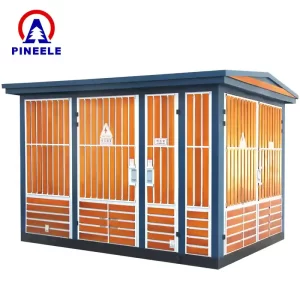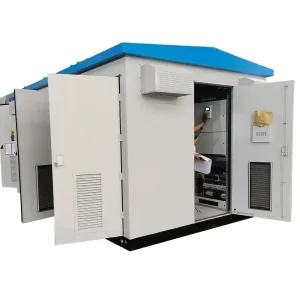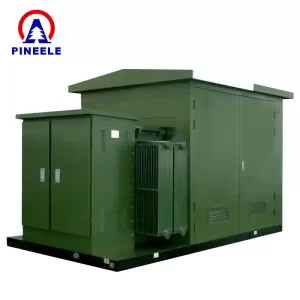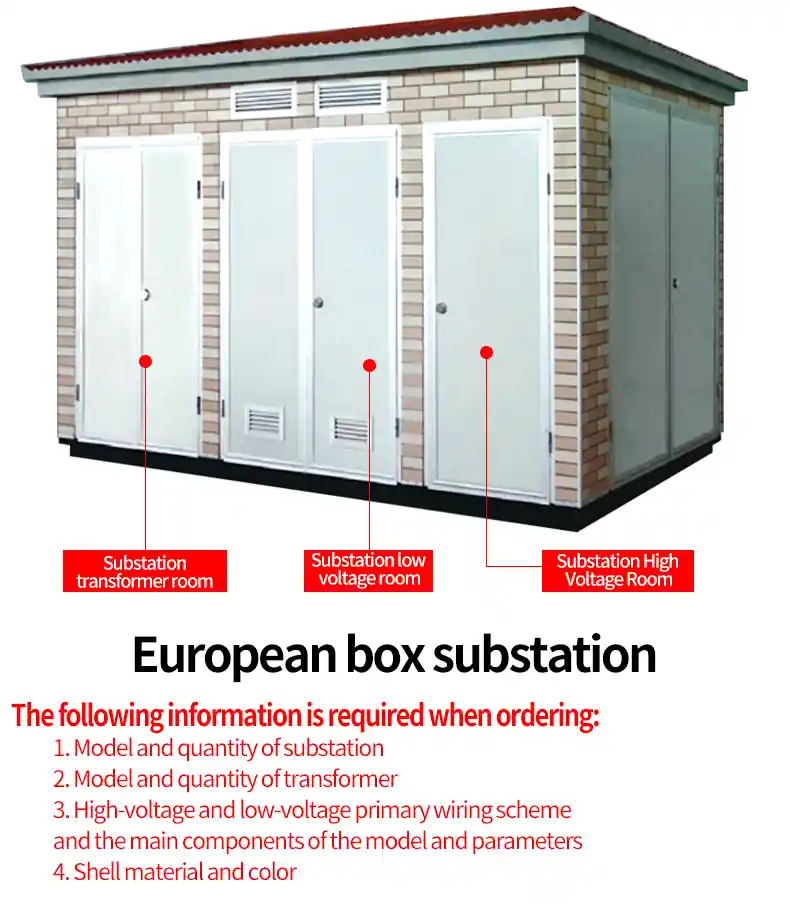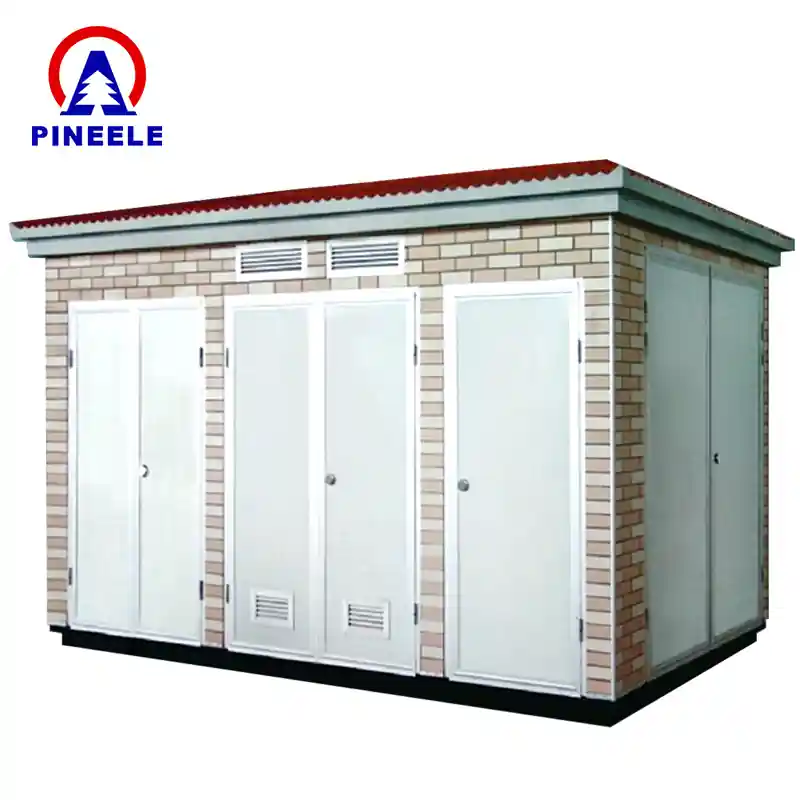
European Standard Compact Substation
The European Standard Compact Substation is a fully integrated, space-efficient power distribution solution designed to meet European safety and performance standards. It combines medium-voltage (MV) switchgear, a distribution transformer, and low-voltage (LV) switchgear within a single, weatherproof enclosure, ensuring reliability, efficiency, and safety for industrial, commercial, and urban applications.
Unlike conventional substations, this compact modular unit reduces installation space while providing seamless power distribution, lower transmission losses, and enhanced energy efficiency. Compliant with IEC 62271-202, it offers robust electrical protection and high operational reliability.
Key Features:
- Compact, fully enclosed design – Enhances safety and reduces maintenance.
- Quick installation – Factory-assembled for easy deployment.
- Advanced protection & monitoring – Ensures system reliability.
- Energy-efficient – Minimizes transmission losses and improves power quality.
- Customizable configurations – Available in various voltage and power ratings.
- Durable & weatherproof – Suitable for indoor and outdoor environments.
Widely used in renewable energy plants, construction sites, mining, data centers, and railway electrification, the European Standard Compact Substation is the ideal choice for modern power distribution, offering high performance, safety, and efficiency.
Product Overview
- The foundation must have a bearing capacity of at least 1000 Pa.
- The foundation should be built on relatively high ground, with external drainage on all sides. Use 200# cement mortar mixed with 3% waterproofing agent, and ensure the bottom slopes slightly towards the oil tank (the oil tank is removed when installing a dry-type transformer).
- The foundation construction should comply with JGJ1683 "Technical Specification for Architectural Power Design" and relevant regulations.
- Grounding electrodes should be installed according to standard specifications, with a grounding resistance ≤ 4 ohms.
- Ambient air temperature: Maximum 40°C, Minimum -25°C.
- Altitude: ≤ 1000 W/m² (For altitudes exceeding 100m, consult for special order details).
- Wind speed: ≤ 35m/s.
- Seismic intensity: ≤ Level 8.
- Ice thickness: ≤ 20mm.
- Humidity:
- Daily average relative humidity ≤ 95%; Monthly average relative humidity ≤ 90%.
- Daily average water vapor pressure ≤ 2.2kPa; Monthly average water vapor pressure ≤ 1.8kPa.
- The installation site should be free from flammable and explosive hazards, chemical corrosion, and severe vibrations.
Note: For special environmental conditions, please specify requirements at the time of order so that the manufacturer can provide solutions accordingly.
What is the IEC standard for compact substation?
The IEC standard for compact substations is primarily defined under IEC 62271-202, which provides guidelines for prefabricated and factory-assembled medium voltage/low voltage (MV/LV) substations. This standard ensures that compact substations are designed, manufactured, and tested to meet the highest safety, reliability, and operational efficiency requirements.
IEC 62271-202 covers the technical requirements, safety considerations, environmental performance, and testing methods for compact secondary substations (CSS) used in power distribution networks up to 52 kV. The standard applies to fully enclosed substations that integrate MV switchgear, a transformer, and LV switchgear within a single, prefabricated enclosure.
Key Requirements of IEC 62271-202 for Compact Substations
- Structural Integrity: The enclosure must be designed to withstand mechanical, electrical, and environmental stresses.
- Internal Arc Protection: The standard defines IAC classifications (e.g., IAC-A, IAC-B, IAC-AB) to protect personnel in case of internal arc faults.
- IP Ratings: Specifies the required level of protection against dust and water ingress (e.g., IP54, IP65).
- Dielectric Strength: Ensures insulation withstands high-voltage stress without breakdown.
- Thermal Stability: Compact substations must dissipate heat efficiently to prevent transformer overheating.
- Short-Circuit Withstand Capability: The MV switchgear and other components must be tested for fault conditions.
- Protection and Control Systems: Requirements for built-in relays, fuses, and circuit breakers to enhance operational safety.
- Environmental Considerations: The substation must be resistant to corrosion, UV radiation, and extreme weather conditions.
Importance of IEC Compliance in Compact Substations
Compliance with IEC 62271-202 ensures that compact substations meet global safety and performance benchmarks. This is particularly important for utility companies, industrial facilities, renewable energy plants, and urban power distribution networks that require high-reliability solutions. IEC-certified compact substations reduce the risk of electrical failures, improve operational efficiency, and enhance system longevity.
Furthermore, the standard supports smart grid integration, enabling modern compact substations to include remote monitoring, automated fault detection, and energy efficiency enhancements. Many leading manufacturers of compact substations design their products to not only comply with IEC 62271-202 but also with regional safety regulations such as ANSI, GB, and EN standards.
The IEC 62271-202 standard plays a critical role in defining the design, testing, and operational requirements for compact substations worldwide. By ensuring compliance with this standard, manufacturers and power utility providers can guarantee safety, reliability, and long-term performance in various applications. Whether used in industrial zones, urban infrastructure, data centers, or renewable energy projects, IEC-certified compact substations provide an essential solution for modern power distribution needs.
European Standard Compact Substation Parameters
| Product Technical Parameters | ||||
|---|---|---|---|---|
| Product Name | Unit | High Voltage Electrical Equipment | High Voltage Electrical Equipment | Low Voltage Electrical Equipment |
| Rated Voltage | kV | 10 | 10 | 0.4 |
| Rated Current | A | 630 | 630 | 100~2500 |
| Rated Frequency | Hz | 50 | 50 | 50 |
| Rated Capacity | kVA | |||
| Rated Thermal Stability Current | kA | 20/4S | 20/4S | 30/15 |
| Rated Dynamic Stability Current (Peak) | kA | 50 | 50 | 63 |
| Rated Closing Short-Circuit Current (Peak) | kA | 50 | 50 | 15~30 |
| Rated Breaking Short-Circuit Current | kA | 31.5 (Fuse) | 31.5 (Fuse) | |
| Rated Load Breaking Current | A | 630 | 630 | |
| 1min Power Frequency Withstand Voltage | kV | To Ground, Phase-to-Phase 42, Interruption 48 | To Ground, Phase-to-Phase 42, Interruption 48 | 20/2.5 |
| Lightning Impulse Withstand Voltage | kV | To Ground, Phase-to-Phase 75, Interruption 85 | To Ground, Phase-to-Phase 75, Interruption 85 | |
| Enclosure Protection Level | IP23 | IP23 | IP23 | |
| Noise Level | dB | |||
| Number of Circuits | 1~6 | 1~6 | 4~30 | |
| Maximum Reactive Power Compensation on Low Voltage Side | kvar | 300 | ||
Product Overview
European compact substations are suitable for urban ring network power supply, dual power supply, or terminal power supply systems. They serve as high-voltage metering, compensation control, and protection devices. The high-voltage side is equipped with four-position load switches, backup fuses, and plug-in fuses. The low-voltage side is configured with control devices, distribution devices, compensation devices, and energy metering units according to user requirements.
Compact substations can be used both indoors and outdoors, widely applied in industrial parks, commercial centers, multi-story buildings, and various other environments.
Product Features
Compact substations integrate high-voltage distribution devices, transformers, and low-voltage distribution equipment into a single unit, forming three functional compartments: high-voltage chamber, transformer chamber, and low-voltage chamber. These chambers provide a complete power supply system that supports ring network power supply, terminal power supply, and dual power supply configurations to meet different power distribution needs. Additionally, high-voltage metering units can be installed to fulfill the requirements of high-voltage energy measurement.
The transformer options include S9/S11/S13/SCB10 series, as well as dry-type or oil-immersed transformers. The low-voltage chamber can be customized using panel or cabinet-type structures according to user requirements, offering various functional solutions such as automatic distribution, lighting distribution, power factor compensation, energy metering, and electrical parameter measurement to meet diverse application needs. These features facilitate efficient power management and improve power supply quality.
The high-voltage chamber adopts a compact design and features a comprehensive interlocking system to prevent operational errors. When required, the transformer chamber can be accessed easily through wide openings, ensuring convenient equipment installation and maintenance. Each compartment is equipped with automatic lighting devices, while all components in the high and low-voltage chambers use fully enclosed equipment for enhanced safety and reliability.
Ventilation is achieved through a combination of natural ventilation and forced ventilation. The transformer, high-voltage, and low-voltage chambers are all equipped with ventilation systems, and temperature control units automatically activate and deactivate exhaust fans based on preset temperature thresholds, ensuring stable transformer operation.
